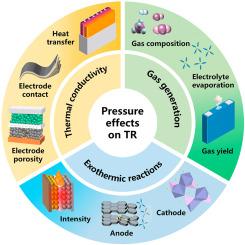外部压力对柱状LiFePO4电池热失控的影响:电动汽车中更安全的电池系统的机理见解
IF 17
1区 工程技术
Q1 ENERGY & FUELS
引用次数: 0
摘要
外部压力对锂离子电池热失控(TR)行为有显著影响。然而,外界压力在TR过程中影响放热反应、传热和气体生成的潜在机制仍有待完全阐明。在这项研究中,通过热分析、时间分辨气相色谱和死后材料表征,系统地研究了外部压力对柱状磷酸铁锂(LFP)电池TR的机制影响。结果表明,0.1和0.2 MPa的外部压力增强了电池内部的界面接触,从而提高了内部导热系数。这一改进使得温度分布更加均匀,从而提高了TR起始温度,使初始TR位置从电池边缘向中心内移动。然而,外部压力加速了热失控传播(TRP),与0 MPa相比,0.2 MPa时的传播速度增加了约65%。此外,气体演化分析表明,随着外部压力的增加,总产气量大幅下降,在0.1 MPa时,总产气量相对于0 MPa下降约28%,在0.2 MPa时,总产气量相对于0 MPa下降53%。这种减少主要归因于早期的安全排气和延长的电解质蒸发周期。死后表征强调了在升高的外部压力下加剧的放热反应,反映了更深层次的电极材料降解。这些发现强调了外部压力的风险缓解作用,从而降低了TRP加速时的爆炸风险,并为在现实机械约束下设计和建模更安全的电池系统提供了信息。本文章由计算机程序翻译,如有差异,请以英文原文为准。

External pressure effects on thermal runaway in prismatic LiFePO4 batteries: Mechanistic insights for safer battery systems in electric vehicles
External pressure significantly influences the thermal runaway (TR) behavior of lithium-ion batteries (LIBs). However, the underlying mechanisms by which external pressure affects exothermic reactions, heat transfer, and gas generation during TR remain to be fully clarified. In this study, the mechanistic effects of external pressure on TR in prismatic lithium iron phosphate (LFP) batteries were systematically investigated through thermal analysis, time-resolved gas chromatography, and postmortem material characterization. Results indicate that external pressures of 0.1 and 0.2 MPa enhance interfacial contact within the battery, thereby increasing internal thermal conductivity. This improvement results in a more uniform temperature distribution, which raises the TR initiation temperature and shifts the initial TR location inward from the battery edge toward the center. However, external pressure accelerates thermal runaway propagation (TRP), with propagation speed at 0.2 MPa increasing by approximately 65 % compared to 0 MPa. Moreover, gas evolution analysis reveals a substantial reduction in total gas yield with increasing external pressure, exhibiting decreases of about 28 % at 0.1 MPa and 53 % at 0.2 MPa relative to 0 MPa. This reduction is primarily attributed to earlier safety venting and prolonged electrolyte evaporation periods. Postmortem characterization highlights intensified exothermic reactions under elevated external pressure, reflecting deeper electrode material degradation. These findings highlight the risk-mitigation effect of external pressure, thereby lowering explosion risk despite the acceleration of TRP, and inform the design and modeling of safer battery systems under realistic mechanical constraints.
求助全文
通过发布文献求助,成功后即可免费获取论文全文。
去求助
来源期刊

Etransportation
Engineering-Automotive Engineering
CiteScore
19.80
自引率
12.60%
发文量
57
审稿时长
39 days
期刊介绍:
eTransportation is a scholarly journal that aims to advance knowledge in the field of electric transportation. It focuses on all modes of transportation that utilize electricity as their primary source of energy, including electric vehicles, trains, ships, and aircraft. The journal covers all stages of research, development, and testing of new technologies, systems, and devices related to electrical transportation.
The journal welcomes the use of simulation and analysis tools at the system, transport, or device level. Its primary emphasis is on the study of the electrical and electronic aspects of transportation systems. However, it also considers research on mechanical parts or subsystems of vehicles if there is a clear interaction with electrical or electronic equipment.
Please note that this journal excludes other aspects such as sociological, political, regulatory, or environmental factors from its scope.
 求助内容:
求助内容: 应助结果提醒方式:
应助结果提醒方式:


